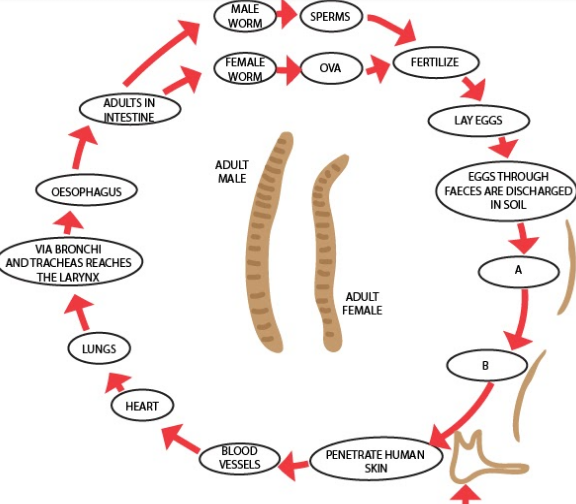
Name the animal whose life cycle is given above?

A) Roundworm, Ascaris
B) Flatworm, Taenia
C) Hookworm, Ancyclostoma
D) Liver fluke, Fasciola hepatica

Answer
515.7k+ views
Hint: There is a stage in a life cycle called metamorphosis where actual improvement occurs after the birth or incubating of a life form's egg. This cycle will cause the progression through separation and division of the body of a creature and its construction.
Complete answer:
Every living life form, whether verdure/flora or fauna, goes through a similar chain of life events from birth to death. The existence pattern of any species incorporates all of the living changes that an organic entity goes through from the beginning of their formative stages to the end of their mature stages. A plant's existence pattern is not the same as a creature's existence pattern, but they all begin with birth and end with death.
A nematode worm is an ancylostoma duodenale. The hookworm of the human intestine is its common name. They infect humans and other mammals with parasitic infections. Hookworm infection begins when the larval stage of the worm penetrates the skin and migrates through the liver and lungs during its life cycle. Filariform larva is the name given to this type of larva. They bind to the intestine and replicate, forming eggs that are eventually released in the faeces. In the soil, the embryonic egg is present in rhabditiform and ripening into filariform larvae. A new breeding cycle begins. In the above diagram the life cycle belongs to the wreath.
The right answer is therefore option C -Hookworm, Ancylostoma.
Note:
Despite the fact that it is a major cycle, every living species' development and advancement stages change. For example, the life cycle of microorganisms is completed in a single age; where parting of the current cell occurs, the cell develops to development and after that parts into two new organic entities, completing its life cycle.
Complete answer:
Every living life form, whether verdure/flora or fauna, goes through a similar chain of life events from birth to death. The existence pattern of any species incorporates all of the living changes that an organic entity goes through from the beginning of their formative stages to the end of their mature stages. A plant's existence pattern is not the same as a creature's existence pattern, but they all begin with birth and end with death.
A nematode worm is an ancylostoma duodenale. The hookworm of the human intestine is its common name. They infect humans and other mammals with parasitic infections. Hookworm infection begins when the larval stage of the worm penetrates the skin and migrates through the liver and lungs during its life cycle. Filariform larva is the name given to this type of larva. They bind to the intestine and replicate, forming eggs that are eventually released in the faeces. In the soil, the embryonic egg is present in rhabditiform and ripening into filariform larvae. A new breeding cycle begins. In the above diagram the life cycle belongs to the wreath.
The right answer is therefore option C -Hookworm, Ancylostoma.
Note:
Despite the fact that it is a major cycle, every living species' development and advancement stages change. For example, the life cycle of microorganisms is completed in a single age; where parting of the current cell occurs, the cell develops to development and after that parts into two new organic entities, completing its life cycle.
Recently Updated Pages
The number of solutions in x in 02pi for which sqrt class 12 maths CBSE

Write any two methods of preparation of phenol Give class 12 chemistry CBSE

Differentiate between action potential and resting class 12 biology CBSE

Two plane mirrors arranged at right angles to each class 12 physics CBSE

Which of the following molecules is are chiral A I class 12 chemistry CBSE

Name different types of neurons and give one function class 12 biology CBSE

Trending doubts
One Metric ton is equal to kg A 10000 B 1000 C 100 class 11 physics CBSE

What is 1s 2s 2p 3s 3p class 11 chemistry CBSE

Discuss the various forms of bacteria class 11 biology CBSE

State the laws of reflection of light

Explain zero factorial class 11 maths CBSE

An example of chemosynthetic bacteria is A E coli B class 11 biology CBSE




